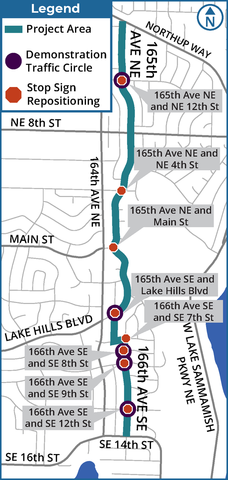
The East Bellevue Demonstration Greenway was installed in summer 2021 and intended to make it easier for people to bicycle and walk around the neighborhood to reach nearby destinations. The two-mile long greenway (map) was installed primarily along 166th and 165th avenues, from Southeast 14th Street to Northup Way. The “demonstration” aspect of the project means the city used quick-build, low-cost treatments, while residents were encouraged to provide feedback before, during and after installation.
Project Evaluation
Following installation, an analysis of the greenway (evaluation report and appendix) was conducted to determine if the project met the project goals. Based on traffic analyses and a community survey, all of the project goals were met:
- Increase the number of bicyclists and pedestrians along the corridor: after the project was built, pedestrian usage increased 16% while bicycle usage increased 160%
- Raise awareness about people walking and biking: of people who have driven along the greenway, 47% agreed they are now more aware of people walking and biking (compared to 37% who disagreed)
- Lower vehicle speeds along the Greenway route: of all traffic measured (at four locations along the Greenway), a lower share of traffic traveled above 25 mph following installation
- Improve perceived safety along the Greenway route: of people who have biked along the greenway, 68% agree they feel safer with the treatments (compared to 21% who did not)
Description
The greenway project (map) treatments are intended to make it safer and more comfortable to bicycle and roll on the corridor. Improvements included:
- Bicycle pavement markings such as sharrow symbols and green paint for higher visibility near busy road crossings
- Rapid-build traffic circles and associated pavement artwork at several locations
- Relocated stop signs at key intersections (see map) to minimize the number of stops for people biking and rolling
- Wayfinding signs directing people to nearby destinations
- New 20 mph speed limit condition (down from 25 mph)
Why a demonstration project?
Demonstration approaches to projects allow for several benefits:
- Provides a low-cost, real-world opportunity to test a neighborhood greenway in Bellevue, and to implement improvements more rapidly and efficiently than traditional project delivery would allow.
- Encourages residents to provide feedback before, during and after installation.
- City staff can monitor traffic conditions and make quick adjustments, if needed.
- Helps to determine appropriate next steps before (potentially) making more expensive, permanent investments.
- Emphasizes data collection to better understand project benefits and impacts that could help guide the implementation of future greenways elsewhere in Bellevue.
Background
In 2020, the city launched Bellevue Healthy Streets, in which several streets – including the 165th/166th avenue corridor – were closed to non-local motor vehicle traffic to allow better physical distancing during the COVID-19 pandemic. The demonstration project builds on Healthy Streets. The 165th/166th avenue corridor also was identified as a bicycling route in the city’s 2009 Pedestrian and Bicycle Transportation Plan, listed in the city’s 2016 Bicycle Rapid Implementation Program (Project Idea NB-1) and noted as a potential next step in Bellevue’s Healthy Streets Evaluation Report.
Next steps
Data and public feedback show that many of the project goals were met and public sentiment about the initiative generally was positive. As such, next steps for the greenway include making the route permanent, enhancing design features along the corridor and evaluating the creation of a dedicated Neighborhood Greenways Program within the City of Bellevue.
Funding
The cost of construction was $153,209 and funded by the voter-approved Neighborhood Safety, Connectivity and Congestion Levy, and by the Neighborhood Traffic Safety program.
Schedule
- Summer 2021: Construction started in late August and was completed in early September.
- Summer 2021 to early 2022: The demonstration period lasted approximately six months, until early 2022.
- Spring 2022: Project evaluation
Outreach material
- East Bellevue Demonstration Greenway Evaluation Report and Appendix (May 2022)
- Take the questionnaire mailer (Sept. 2021)
- Notice of Installation mailer (Aug. 2021)
- Stop sign repositioning map (Aug. 2021)
- Traffic circle decorative pattern survey results (May 2021)
- Project update (April 2021)
